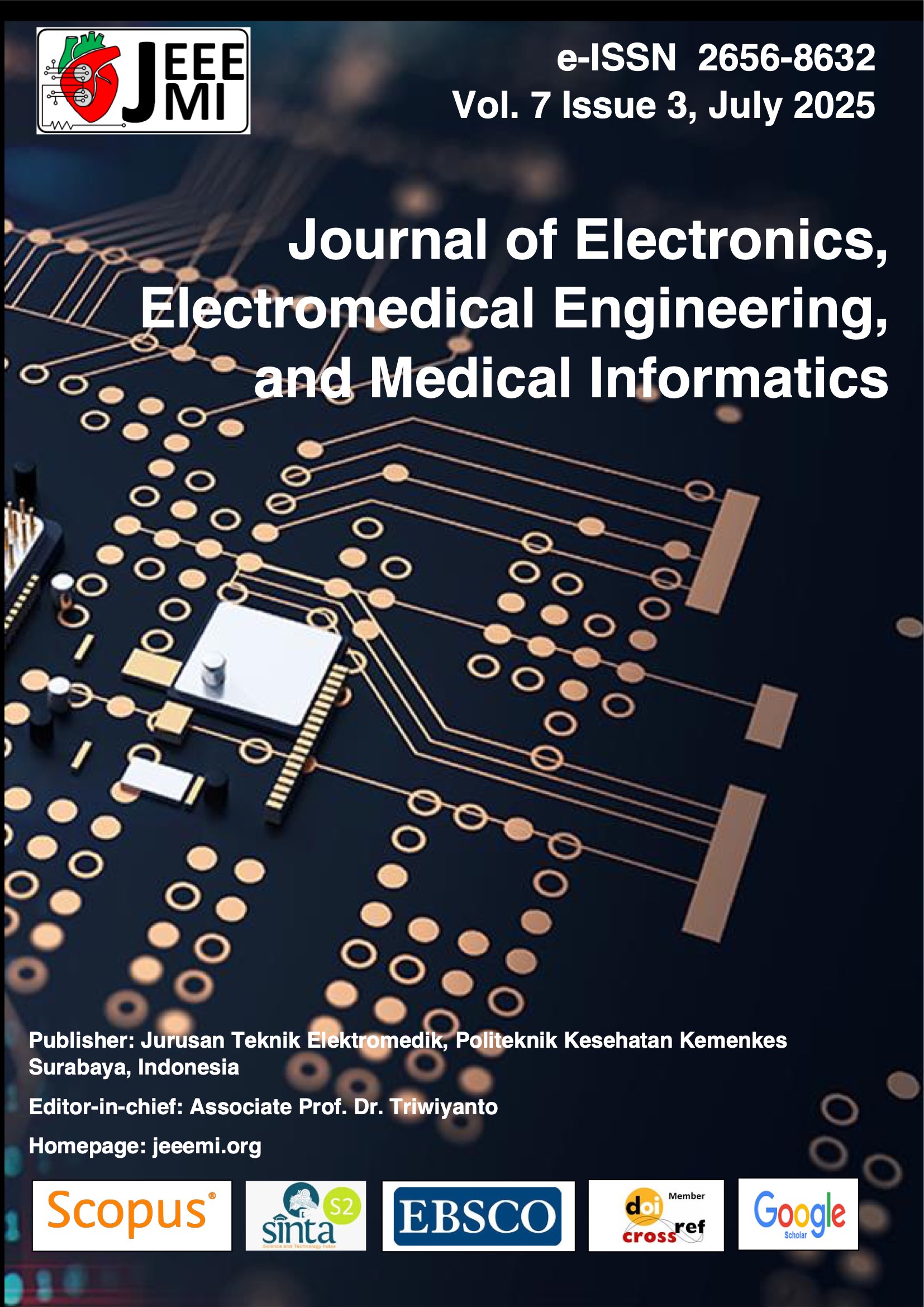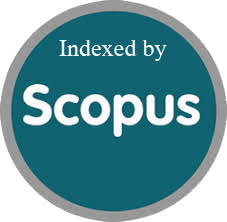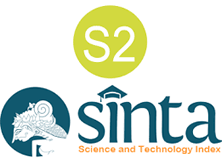Improving Kidney Stone Detection with YOLOV10 and Channel Attention Mechanisms in Medical Imaging
Abstract
Accurate and timely detection of kidney stones is crucial for effective medical intervention and treatment planning. However, existing detection methods often struggle with challenges related to sensitivity, precision, and the ability to process complex and variable medical images. In this study, an advanced kidney stone detection system is developed using the latest object detection algorithm, You Only Look Once version 10 (YOLOv10), integrated with channel attention mechanisms to enhance model performance. This combination aims to improve detection accuracy by enabling the network to focus more precisely on critical regions in medical images, particularly in Computed Tomography (CT) scans, where kidney stones may appear in varying shapes, sizes, and intensities. The proposed system begins with data augmentation techniques, such as rotation, scaling, and contrast adjustments, to enhance the model’s generalization ability across different image conditions and patient profiles. YOLOv10 was selected due to its lightweight architecture, high detection speed, and enhanced performance in small object detection tasks. To further improve feature extraction, channel attention mechanisms such as Squeeze-and-Excitation (SE) blocks or Efficient Channel Attention (ECA) modules are incorporated. These modules enable the network to selectively focus on the most informative feature channels associated with kidney stone regions, while suppressing irrelevant background information, thereby improving the distinction between stones and surrounding tissues. The model is trained and fine-tuned using a diverse CT scan dataset containing various types and sizes of kidney stones. Evaluation results demonstrate that the proposed model achieves a high detection accuracy of 93.7% with a very low loss of 0.18. It exhibits stability without issues like overfitting, underfitting, or local minima entrapment, making it a highly reliable tool for clinical applications.
Downloads
References
S., S., & V., S. “FACNN: Fuzzy-based adaptive convolution neural network for classifying COVID-19 in noisy CXR images”. Medical & Biological Engineering & Computing, Vol.62, pp.2893–2909, 2024, doi:10.1007/s11517-024-03107-x
Kim J, Kwak CW, Uhmn S, Lee J, Yoo S, Cho MC, Son H, Jeong H, Choo MS. A Novel Deep Learning–based Artificial Intelligence System for Interpreting Urolithiasis in Computed Tomography. European Urology Focus. 2024 Jul 12. DOI: 10.1016/j.euf.2024.07.003
Wahid F, Ma Y, Khan D, Aamir M, Bukhari SU. Biomedical Image Segmentation: A Systematic Literature Review of Deep Learning Based Object Detection Methods. arXiv preprint arXiv:2408.03393. 2024 Aug 6.
Lien WC, Chang YC, Chou HH, Lin LC, Liu YP, Liu L, Chan YT, Kuan FS. Detecting hydronephrosis through ultrasound images using state-of-the-art deep learning models. Ultrasound in Medicine & Biology. 2023 Mar 1;49(3):723-33.DOI: 10.1016/j.ultrasmedbio.2022.10.001
Thirunavukarasu R, Kotei E. A comprehensive review on transformer network for natural and medical image analysis. Computer Science Review. 2024 Aug 1;53:100648. https://doi.org/10.1016/j.cosrev.2024.100648
Gonzalez-Zapata J, Lopez-Tiro F, Villalvazo-Avila E, Flores-Araiza D, Hubert J, Ochoa-Ruiz G, Daul C, Mendez-Vazquez A. A metric learning approach for endoscopic kidney stone identification. Expert Systems with Applications. 2024 Dec 1;255:124711. https://doi.org/10.1016/j.eswa.2024.124711
Pande SD, Agarwal R. Multi-class kidney abnormalities detecting novel system through computed tomography. IEEE Access. 2024 Jan 8. 10.1109/ACCESS.2024.3351181
Suhail K, Brindha D. Microscopic urinary particle detection by different YOLOv5 models with evolutionary genetic algorithm based hyperparameter optimization. Computers in Biology and Medicine. 2024 Feb 1;169:107895. https://doi.org/10.1016/j.compbiomed.2023.107895
Mahmud S, Abbas TO, Chowdhury ME, Mushtak A, Kabir S, Muthiyal S, Koko A, Altyeb AB, Alqahtani A, Khandakar A, Islam SM. Automated grading of prenatal hydronephrosis severity from segmented kidney ultrasounds using deep learning. Expert Systems with Applications. 2024 Dec 1;255:124594. http://dx.doi.org/10.1016/j.eswa.2024.124594
Baygin M, Yaman O, Barua PD, Dogan S, Tuncer T, Acharya UR. Exemplar Darknet19 feature generation technique for automated kidney stone detection with coronal CT images. Artificial Intelligence in Medicine. 2022 May 1;127:102274. DOI: 10.1016/j.artmed.2022.102274
Asif S, Zheng X, Zhu Y. An optimized fusion of deep learning models for kidney stone detection from CT images. Journal of King Saud University-Computer and Information Sciences. 2024 Sep 1;36(7):102130. https://doi.org/10.1016/j.jksuci.2024.102130
Gulhane M, Kumar S, Choudhary S, Rakesh N, Zhu Y, Kaur M, Tandon C, Gadekallu TR. Integrative approach for efficient detection of kidney stones based on improved deep neural network architecture. SLAS technology. 2024 Aug 1;29(4):100159. DOI: 10.1016/j.slast.2024.100159
Qiu X, Xu Q, Ge H, Gao X, Huang J, Zhang H, Wu X, Lin J. Label-free detection of kidney stones urine combined with SERS and multivariate statistical algorithm. Spectrochimica Acta Part A: Molecular and Biomolecular Spectroscopy. 2025 Jan 5;324:125020. DOI: 10.1016/j.saa.2024.125020
Chaki J, Ucar A. An efficient and robust approach using inductive transfer-based ensemble deep neural networks for kidney stone detection. IEEE Access. 2024 Feb 26. 10.1109/ACCESS.2024.3370672
Liu H, Ghadimi N. Hybrid convolutional neural network and Flexible Dwarf Mongoose Optimization Algorithm for strong kidney stone diagnosis. Biomedical Signal Processing and Control. 2024 May 1;91:106024. 10.1016/j.bspc.2024.106024
Chang YJ, Lin CH, Chien YC. Predicting the risk of chronic kidney disease based on uric acid concentration in stones using biosensors integrated with a deep learning-based ANN system. Talanta. 2025 Feb 1;283:127077. DOI: 10.1016/j.talanta.2024.127077
Patro KK, Allam JP, Neelapu BC, Tadeusiewicz R, Acharya UR, Hammad M, Yildirim O, Pławiak P. Application of Kronecker convolutions in deep learning technique for automated detection of kidney stones with coronal CT images. Information Sciences. 2023 Sep 1;640:119005. 10.1016/j.ins.2023.119005
Suganyadevi, S., Pershiya, A. S., Balasamy, K., et al. “Deep learning based alzheimer disease diagnosis: A comprehensive review”. SN Computer Science, Vol.5 no.4, pp.391, 2024, doi:10.1007/s42979-024-02743-2
Balasamy, K., Krishnaraj, N., & Vijayalakshmi, K. “An adaptive neuro-fuzzy based region selection and authenticating medical image through watermarking for secure communication”, Wireless Personal Communications, Vol.122, no.3, pp. 2817–2837, 2021, doi:10.1007/s11277-021-09031-9.
Suganyadevi, S., & Seethalakshmi, V. “CVD-HNet: Classifying Pneumonia and COVID-19 in Chest X-ray Images Using Deep Network”. Wireless Personal Communications, Vol.126, no. 4, pp.3279–3303, 2022, doi: 10.1007/s11277-022-09864-y
Balasamy, K., & Suganyadevi, S. “Multi-dimensional fuzzy based diabetic retinopathy detection in retinal images through deep CNN method”. Multimedia Tools and Applications, Vol 83, no. 5, pp.1–23. 2024, doi: 10.1007/s11042-024-19798-1
Shamia, D., Balasamy, K., and Suganyadevi, S. “A secure framework for medical image by integrating watermarking and encryption through fuzzy based roi selection”, Journal of Intelligent & Fuzzy systems, 2023, Vol. 44, no.5, pp.7449-7457, doi: 10.3233/JIFS-222618.
Balasamy, K., Seethalakshmi, V. & Suganyadevi, S. Medical Image Analysis Through Deep Learning Techniques: A Comprehensive Survey. Wireless Pers Commun 137, 1685–1714 (2024). https://doi.org/10.1007/s11277-024-11428-1.
Suganyadevi, S., Seethalakshmi, V. Deep recurrent learning based qualified sequence segment analytical model (QS2AM) for infectious disease detection using CT images. Evolving Systems 15, 505–521 (2024). https://doi.org/10.1007/s12530-023-09554-5.
Caglayan A, Horsanali MO, Kocadurdu K, Ismailoglu E, Guneyli S. Deep learning model-assisted detection of kidney stones on computed tomography. Int Braz J Urol. 2022 Sep-Oct;48(5):830-839. doi: 10.1590/S1677-5538.IBJU.2022.0132
S. M B and A. M R, "Kidney Stone Detection Using Digital Image Processing Techniques," 2021 Third International Conference on Inventive Research in Computing Applications (ICIRCA), Coimbatore, India, 2021, pp. 556-561, doi: 10.1109/ICIRCA51532.2021.9544610.
P. T. Akkasaligar, S. Biradar and V. Kumbar, "Kidney stone detection in computed tomography images," 2017 International Conference On Smart Technologies For Smart Nation (SmartTechCon), Bengaluru, India, 2017, pp. 353-356, doi: 10.1109/SmartTechCon.2017.8358395.
Nuhad A. Malalla, Pengfei Sun, Ying Chen, Michael E. Lipkin, Glenn M. Preminger and Jun Qin, "C-arm technique with distance driven for nephrothalisis and kidney stones detection: Preliminary Study", EBMS International Conference on Biomedical and Health Informatics (BHI), pp. 164-167, 2016.
Mostafa Sadeghi, Masoud Shafiee, Faezeh Memarzadeh-Zavareh and Hossein Shafieirad, "A new method for the diagnosis of urinary tract stone in radiographs with image processing", 2nd International Conference on Computer Science and Network Technology (ICCSNT), pp. 2242-2244, 2012.
K. Balasamy, V. Seethalakshmi, “HCO-RLF: Hybrid classification optimization using recurrent learning and fuzzy for COVID-19 detection on CT images”, Biomedical Signal Processing and Control,
Volume 100, Part A, 2025, 106951, https://doi.org/10.1016/j.bspc.2024.106951.
K.M. Black, H. Law, A. Aldoukhi, J. Deng, K.R. Ghani, Deep learning computer vision algorithm for detecting kidney stone composition, BJU Int. 125 (6) (2020) 920–924.
A. Martínez, D.-H. Trinh, J. El Beze, J. Hubert, P. Eschwege, V. Estrade, L. Aguilar, C. Daul, G. Ochoa, Towards an automated classification method for ureteroscopic kidney stone images using ensemble learning, in: 2020 42nd Annual International Conference of the IEEE Engineering in Medicine & Biology Society, EMBC, IEEE, 2020, pp. 1936–1939.
I. Sarker, Machine learning: algorithms, real-world applications and research directions. SN Comput Sci 2: 160, 2021.
N. Ahmed, R. Amin, H. Aldabbas, D. Koundal, B. Alouffi, T. Shah, Machine learning techniques for spam detection in email and IoT platforms: analysis
and research challenges, Secur. Commun. Networks 2022 (2022) 1–19.
N. Chafai, I. Hayah, I. Houaga, B. Badaoui, A review of machine learning models applied to genomic prediction in animal breeding, Front. Genet. 14 (2023) 1150596.
G. Naidu, T. Zuva, E.M. Sibanda, A review of evaluation metrics in machine learning algorithms, in: Computer Science on-Line Conference, Springer, 2023, pp. 15–25.
Renuka Devi, K., Suganyadevi, S and Balasamy, K.. “Healthcare Data Analysis U sing Deep Learning Paradigm ”. Deep Learning for Cognitive Computing Systems: Technological Advancements and Applications, edited by M.G. Sumithra, Rajesh Kumar Dhanaraj, Celestine Iwendi and Anto Merline Manoharan, Berlin, Boston:De Gruyter, 2023, pp. 129–148. https://doi.org/10.1515/9783110750584–008.
M. Hossin, M.N. Sulaiman, A review on evaluation metrics for data classification evaluations, Int. J. Data Min. Knowl. Manag. Process. 5 (2) (2015) 1.
S.A. Khan, K. Iqbal, N. Mohammad, R. Akbar, S.S.A. Ali, A.A. Siddiqui, A novel fuzzy-logic-based multi-criteria metric for performance evaluation of spam email detection algorithms, Appl. Sci. 12 (14) (2022) 7043.
R. Goel, A. Jain, Improved detection of kidney stone in ultrasound images using segmentation techniques, in: Advances in Data and Information Sciences: Proceedings of ICDIS 2019, Springer, 2020, pp. 623–641.
Copyright (c) 2025 Satheeswaran V, Saroj Bala , Kumud Arora , Mohan, Deepika, Sangamithrai

This work is licensed under a Creative Commons Attribution-ShareAlike 4.0 International License.
Authors who publish with this journal agree to the following terms:
- Authors retain copyright and grant the journal right of first publication with the work simultaneously licensed under a Creative Commons Attribution-ShareAlikel 4.0 International (CC BY-SA 4.0) that allows others to share the work with an acknowledgement of the work's authorship and initial publication in this journal.
- Authors are able to enter into separate, additional contractual arrangements for the non-exclusive distribution of the journal's published version of the work (e.g., post it to an institutional repository or publish it in a book), with an acknowledgement of its initial publication in this journal.
- Authors are permitted and encouraged to post their work online (e.g., in institutional repositories or on their website) prior to and during the submission process, as it can lead to productive exchanges, as well as earlier and greater citation of published work (See The Effect of Open Access).





.png)
.png)
.png)
.png)
.png)
